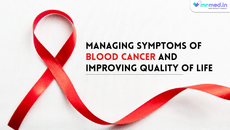Managing the side effects of high-risk Myelodysplastic Syndrome (MDS) treatment, such as fatigue and nausea, can be challenging but is essential for maintaining a good quality of life during therapy. High-risk MDS, a type of blood cancer that impacts the production of healthy blood cells, often requires intensive treatment that can lead to debilitating side effects. This guide will explore effective strategies to combat fatigue and nausea and support overall wellness during MDS treatment.
What Causes Fatigue and Nausea during High-Risk MDS Treatment?
MDS treatments, especially chemotherapy and certain targeted therapies, can impact your energy levels, gastrointestinal health, and appetite. Here are some specific reasons why fatigue and nausea may arise during treatment:
- Chemotherapy: Commonly used in MDS, chemotherapy not only targets cancerous cells but also impacts healthy ones, leading to fatigue, digestive discomfort, and nausea.
- Blood Transfusions: Many MDS patients require frequent blood transfusions, which may temporarily alleviate fatigue but can also lead to mild nausea due to changes in blood cell levels.
- Medications: Medicines like Azashine 200mg Tablet containing Azacitidine can help tackle Myelodysplastic syndrome
Tips for Reducing Fatigue during MDS Treatment
Fatigue is one of the most common side effects experienced during high-risk MDS treatment. However, there are several ways to boost your energy and cope with this symptom:
Prioritise Rest and Quality Sleep
- Aim for 7-8 hours of uninterrupted sleep each night.
- Create a comfortable sleep environment by keeping your room dark, quiet, and cool.
- Establish a relaxing bedtime routine, avoiding electronic devices that emit blue light an hour before bed.
Incorporate Light Physical Activity
- Gentle activities, like stretching, yoga, and walking, can improve energy levels.
- Start slowly, and listen to your body—any movement is beneficial, but don't overexert yourself.
- Regular activity promotes blood flow, reduces stress, and supports energy levels.
Stay Hydrated
- Dehydration can exacerbate feelings of fatigue.
- Drink at least 8-10 glasses of water daily, or more if recommended by your doctor.
- You can also consume hydrating foods, such as fruits and vegetables, to maintain energy levels.
Effective Ways to Manage Nausea During MDS Treatment
Nausea can make it difficult to eat, maintain nutrition, and enjoy daily life. To ease this symptom, try these strategies:
Eat Small, Frequent Meals
- Instead of three large meals, opt for 5-6 smaller meals spread throughout the day.
- This approach reduces the strain on your digestive system and helps maintain steady blood sugar levels, reducing nausea.
Choose Gentle Foods
- Bland foods like rice, bananas, applesauce, and toast are easier on the stomach.
- Avoid heavy, spicy, or greasy foods that can trigger nausea.
Ginger and Peppermint Remedies
- Ginger has been shown to ease nausea, and you can consume it as tea or as supplements.
- Peppermint can also be effective—try peppermint tea or simply inhaling peppermint oil to ease nausea.
Stay Upright after Eating
- Remaining upright for at least 30 minutes after meals can help reduce nausea.
- Lying down immediately after eating may increase the chance of acid reflux, which can worsen nausea.
Nutritional Support for Energy and Recovery
Nutrition plays a pivotal role in managing fatigue and nausea during MDS treatment. A balanced diet can provide the energy your body needs for recovery and resilience:
Incorporate Iron-Rich Foods
- Many MDS patients experience anaemia, leading to fatigue. Iron-rich foods like leafy greens, beans, and lean meats can support energy levels.
- Consult your doctor to see if iron supplements are recommended in your case.
Focus on Protein-Rich Foods
- Protein is essential for muscle maintenance and recovery.
- Include protein sources such as eggs, fish, poultry, legumes, and dairy in your diet to support your body's needs.
Limit Processed Foods and Sugars
- High-sugar and highly processed foods can cause rapid spikes and crashes in blood sugar levels, increasing fatigue.
- Instead, opt for whole foods with natural sugars, like fruits, to keep your energy steady.
Managing Weight Loss and Nutritional Intake
Unintentional weight loss can be common during MDS treatment due to decreased appetite and nausea. Here are some tips for managing weight loss and maintaining healthy body weight:
Choose High-Calorie Nutrient-Dense Foods
- Foods like avocados, nuts, and olive oil provide healthy fats and calories without requiring large portions.
- Add extra calories where you can, like a spoonful of peanut butter with fruit or olive oil drizzled on vegetables.
Consider Meal Supplements
- Nutritional shakes or supplements can be a convenient way to consume calories and nutrients.
- Consult your healthcare team to identify supplements that are appropriate for you.
Alternative Therapies to Alleviate Symptoms
Alternative therapies can support fatigue and nausea management, enhancing your overall treatment experience.
Acupuncture
- Some studies show acupuncture may reduce chemotherapy-induced nausea and fatigue.
- Discuss this option with your healthcare provider to see if it's safe for you.
Mindfulness and Meditation
- Practices like deep breathing, progressive muscle relaxation, and guided imagery can help manage stress, indirectly reducing fatigue and nausea.
- Regular meditation can also improve your resilience to stressors, supporting better mental and emotional health.
When to Seek Help for Severe Symptoms?
While it's common to experience fatigue and nausea during MDS treatment, certain symptoms may indicate a need for more medical attention. Here’s when you should contact your healthcare provider:
- Persistent or worsening fatigue that doesn’t improve with rest or hydration
- Severe or prolonged nausea, especially if it leads to vomiting or dehydration
- Sudden weight loss that affects your strength and well-being
Your healthcare provider can offer additional resources or adjust your treatment plan to reduce these symptoms.




